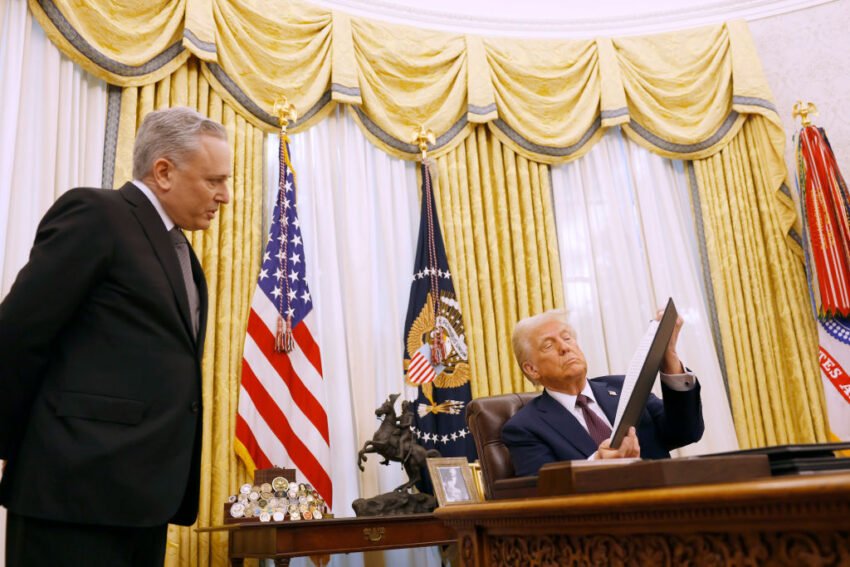David Sacks, U.S. President Donald Trump’s “AI and Crypto Czar”, speaks to President Trump as he signs a series of executive orders in the Oval Office of the White House on Jan. 23, 2025 in Washington, D.C. Trump signed a range of executive orders pertaining to issues including crypto currency and artificial intelligence. (Photo by Anna Moneymaker/Getty Images)
The Trump administration wants to greatly expand the development and use of advanced artificial intelligence, including rolling back environmental rules to spur building of power-thirsty data centers and punishing states that attempt to regulate AI on their own.
The administration’s action plan, called “Winning the AI Race: America’s AI Action Plan,” released on Wednesday, is a result of six months of research by tech advisors, after Trump removed President Joe Biden’s signature AI guardrails on his first day in office. The plan takes a hands-off approach to AI safeguards, and invests in getting more American workers to use AI in their daily lives.
“To win the AI race, the U.S. must lead in innovation, infrastructure, and global partnerships,” AI and Crypto Czar David Sacks said in a statement. “At the same time, we must center American workers and avoid Orwellian uses of AI. This Action Plan provides a roadmap for doing that.”
President Donald Trump was expected to release AI-related executive orders later Wednesday, and was slated to speak at the “Winning the AI Race” Summit Hosted by the Hill & Valley Forum, a group of lawmakers and venture capitalists and the All‑In Podcast, which is co-hosted by AI Czar Sacks, Wednesday evening.
The action plan outlines three major pillars — accelerate AI innovation, build American AI infrastructure and lead in international AI diplomacy and security.
The Trump administration says that to accelerate AI in the U.S., it needs to “remove red tape,” around “onerous” AI regulations. The plan recommends the Office of Science and Technology Policy inquire with businesses and the public about federal regulations that hinder AI innovation, and suggests the federal government end funding to states “with burdensome AI regulations.”
The plan does say that these actions should not interfere with states’ ability to pass AI laws that are not “unduly restrictive,” despite unsuccessful attempts by Congressional Republicans to impose an AI moratorium for the states.
The plan also says that free speech should be prioritized in AI, saying models must be trained so that “truth, rather than social engineering agendas” are the focus of model outputs. The plan recommends that the Department of Commerce and National Institute of Standards and Technology (NIST), revise the NIST AI Risk Management Framework to eliminate references to misinformation, DEI and climate change.
The Trump administration also pushes for AI to be more widely adopted in government roles, manufacturing, science and in the Department of Defense, and proposes increased funding and regulatory sandboxes — separate trial spaces for AI to be developed — to do so.
To support the proposed increases in AI use, the plan outlines a streamlined permitting process for data centers, which includes lowering or dropping environmental regulations under the Clean Air Act, the Clean Water Act and others. It also proposes making federal lands available for data center construction, and a push that American products should be used in building the infrastructure.
The Action Plan warns of cybersecurity risks and potential exposure to adversarial threats, saying that the government must develop secure frontier AI systems with national security agencies and develop “AI compute control enforcement,” to ensure security in AI systems and with semiconductor chips. It encourages collaboration with “like-minded nations” working toward AI models with shared values, but says it will counter Chinese influence.
“These clear-cut policy goals set expectations for the Federal Government to ensure America sets the technological gold standard worldwide, and that the world continues to run on American technology,” Secretary of State and Acting National Security Advisor Marco Rubio said in a statement.
The policy goals outlined in the plan fall in line with the deregulatory attitude Trump took during his campaign, as he more closely aligned himself with Silicon Valley tech giants, many of whom turned Trump donors. The plan paves the way for continued unfettered growth of American AI models, and outlines the huge energy and computing power needed to keep up with those goals.
Sam Altman, CEO of OpenAI — one of the tech giants that stands to flourish under the proposed policies — spoke Tuesday about the productivity and innovation potential that AI has unlocked. The growth of AI in the last five years has surprised even him, Altman said. But it also poses very real risks, he said, mentioning emotional attachment and overreliance on AI and foreign risks.
“Without a drop of malevolence from anyone, society can just veer in a sort of strange direction,” Altman said.
Note: This story will be updated.
Click this link for the original source of this article.
Author: Paige Gross
This content is courtesy of, and owned and copyrighted by, https://www.nevadacurrent.com and its author. This content is made available by use of the public RSS feed offered by the host site and is used for educational purposes only. If you are the author or represent the host site and would like this content removed now and in the future, please contact USSANews.com using the email address in the Contact page found in the website menu.








